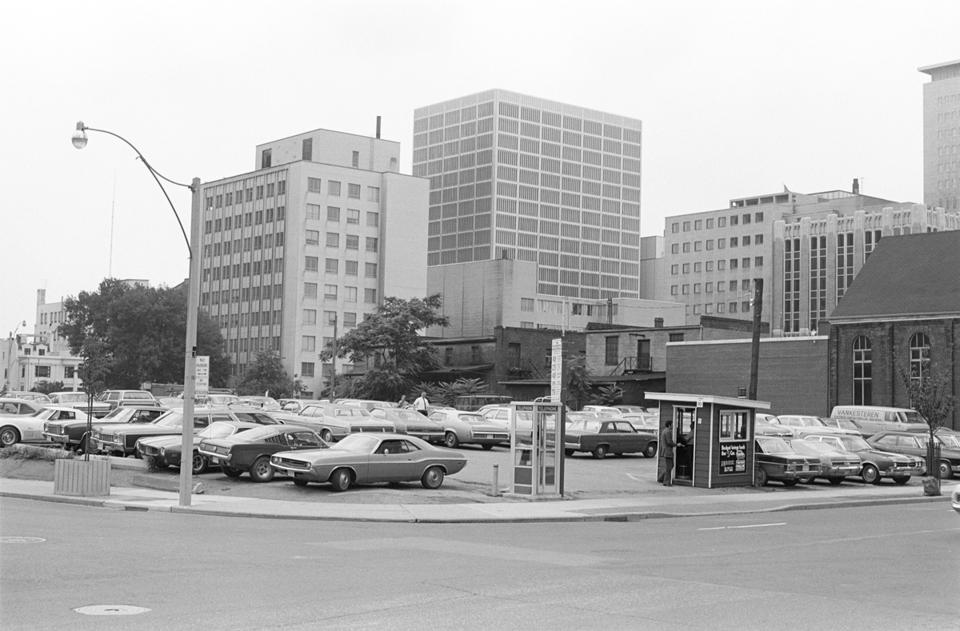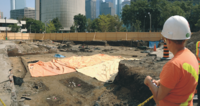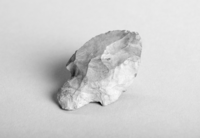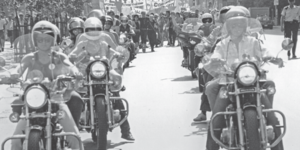
The Object is the Subject by John Lorinc and Tatum Taylor
An excerpt from The Ward Uncovered: The Archaeology of Everyday Life

The office workers were the first to notice the curious scene far below their windows: unusually high construction hoardings, across-hatching of test trenches, and, finally, the footings of a building emerging from the asphalt, like an apparition.
Throughout early 2015, this tableau – the early phases of an extensive year-long archaeological dig – developed quietly on a piece of real estate that few downtowners thought twice about. The 1.6-acre parking lot – bounded by Centre Avenue, Chestnut Street, and Armoury Street – had sat there for years, flanked by commercial buildings, the blank side of an adjacent hotel, a University of Toronto student residence, and the 361 University Avenue courthouse.
Surface lots in recent years have become increasingly scarce due to the voracity of Toronto’s development boom. Yet this one lingered, distinguished only by its continued existence. It’s safe to assume that few of the lot’s customers or the pedestrians who cut across it had ever paused to imagine what lay beneath the asphalt.
That dig, the subject of this anthology, has proven to be a dramatic moment in the history of a city that doesn’t do an especially good job of remembering its past. Dramatic, because the excavation – commissioned by Infrastructure Ontario (IO) and completed by London, Ontario-based Timmins Martelle Heritage Consultants – ranks as one of the largest urban archaeological projects ever carried out in Canada. Its scale rivals vast digs in locations such as New York City’s Five Points, in lower Manhattan.

The excavation yielded between 300,000 and 500,000 artifacts, ranging from a 2,000-year-old Onondaga projectile point to mid-twentieth- century commercial signs. Together, these artifacts offer unprecedented insights into thecomplex and multi-layered stories of an immigrant neighbourhood that existed, in various forms, on that unprepossessing block from the 1830s until the 1988 demolition of the site’s final structure – a brick church at 92 Chestnut Avenue that traced its roots to a c. 1842 wood-frame chapel established there by formerly enslaved African Americans.
The block itself occupied a corner of St.John’s Ward, a.k.a. The Ward, an area bordered by Queen, College, Yonge, and University. This part of the city began to develop from the 1830s onwards as a modest working-class neighbourhood consisting of small cottages, taverns, shops, and even a few bowling alleys. Decades before The Ward became shorthand for squalor in turn-of-the-century Toronto, this community had begun to accommodate waves of newcomers arriving to the city.
During the 1840s and 1850s, St.John’s Ward, but especially streets such as Centre, Chestnut, Elizabeth, and Agnes, became home to hundreds of African Americans fleeing slavery via the Underground Railroad. The area also served as a landing point, along with many other parts of the city, for thousands of Irish migrants fleeing the devastating potato famine. By the 1880s, Italian labourers began migrating to Toronto, settling in a cluster of rooming houses and small shops around Edward and Chestnut Streets, just north of the bus station.
By the mid-1890s, The Ward saw the arrival of thousands of Eastern European Jews fleeing brutal pogroms. After the area’s Jewish population had decamped to Kensington Market, the neighbourhood in the 1920s rapidly evolved into a hub of Chinese settlement.
The district became infamous for its overcrowded conditions. Cluttered backyards were lined with reeking outdoor privies. Meanwhile, a small army of social reformers fanned out across The Ward, looking for converts, juvenile delinquents, and bootleggers.
Soon after the end of World War II, however, city officials voted to raze the community, embarking on a prolonged process of land expropriation to make space for a new city hall. This exercise in slum clearance closed out a long period of stigmatization directed at The Ward’s generations of residents, whose languages, customs, cultural habits, religions, and commercial practices were intolerably alien in a city that saw itself as more British than the British.
The city block that eventually became the Armoury Street dig can be seen as a microcosm of a microcosm – a tiny piece of Toronto that was both unremarkable and yet rich in the sort of social history that has often been overlooked in the narratives of our civic past.
The Ward in the mid-nineteenth century was known for its rowdy taverns and incidents of street crime. In 1858, a house on Sayer Street (later Chestnut) just north of Osgoode Hall was the scene of a violent gang rape: fifteen men attacked Mary Hunt and Ellen Rogers, who likely ran a brothel. During the highly publicized trial, the two women courageously insisted that the fact they were prostitutes didn’t mean the accused should go free – a view of justice sharply at odds with prevailing attitudes.
Through the second half of the nineteenth century, with more immigrants moving into the area, the residential properties on Centre and Chestnut became denser, with an accumulation of rear houses and privies. As the block became increasingly industrial, some of these dwellings were replaced with factories.
After the turn of the century, a handful of small synagogues opened along Centre and Chestnut Streets, including one, Shaarei Tzedec, that set up shop in an old foundry. Directly behind it sat the stately British Methodist Episcopal Church, on Chestnut – the Black church that had grown out of the c. 1842 wood-frame chapel.
By the 1910s, a pair of brick-and-beam factories, each four storeys high with numerous tenants, had gone up on Chestnut Street north of Armoury. One, located directly south of the  Church, was leased during World War by Eaton’s for its tents and awnings operation. These warehouses, which wouldn’t be out of place on Spadina today, loomed over Chestnut until they were demolished in the late 1950s.
The block’s population and demographics mirrored that of the broader Ward – labourers, merchants, tradespeople, and many immigrant families struggling to establish a toehold – and a future – in a foreign place. At various times, the residents were Black, Irish, Jewish, and also British; only the ethnic mixing was a constant.
Some led ordinary lives filled with the usual joys and sorrows, hardships and opportunities. Many others, however, found themselves caught up in the cross-currents of broader historical dramas that originated in faraway p laces but left imprints on this seemingly undistinguished city block.

The survival of these stories and the accompanying archaeological evidence represent an almost impossible coincidence. If the property had been developed earlier, all those objects would have been sent to landfill or dumped in the lake. If former property owners had made different investment choices, the parking lot itself may never have been assembled. If the ground hadn’t been quite so waterlogged, much of the evidence would have decomposed. And if the province had identified another space for the new provincial courthouse that is going up on the site, the lot could have ended up in the hands of a private developer that might have been far less willing than to make a serious investment in archaeology and heritage preservation.
Instead, the stars and planets aligned to preserve this uniquely rich trove of Toronto’s immigration history, which is no small outcome in a city region that has become home to a larger proportion of foreign-born residents than any other metropolitan area in the world.
The Armoury Street Dig lifted the asphalt veil from the remains of a century that had settled into layers of damp soil. For years, shoe leather had rested alongside ceramics; dolls and dentures had lain beneath lines of cars; and the lives that once animated these interred objects had faded from urban awareness. With the site’s excavation in 2015, however, one point became clear: this was not a burial but rather a decades-long hibernation. Now that we’ve coaxed these past belongings back to life, they’re challenging popular notions of what it means to be an artifact.
As this excavation – and others like it – has demonstrated, archaeology can elevate everyday objects to a realm that should not belong only to Egyptian tombs and Grecian urns. This discipline investigates ancient pottery as readily as twentieth- century eating habits and privy lore. Viewed even more broadly, archival photographs and texts can be artifacts; perhaps memories, too, can be seen as artifacts, provided we find ways to capture them. The act of sifting and studying all this material reveals new insights into our ancestors’ lives. It also raises questions about our relationships with time and the physical world: what do we – as individuals, families, and communities – carry with us, either purposefully or unknowingly, as we move through generations? And what traces do we leave behind?
In contemporary Toronto, as in many cities, the objects we don’t keep often wind up in distant landfills – which became a common form of waste management in the mid-nineteenth century – or recycling plants, or perhaps on the shelves of second-hand shops. One person’s garbage is another’s vintage bargain.
Torontonians might be surprised to learn that the Leslie Street Spit, a beloved recreational area and ‘urban wilderness’ not far from downtown, is essentially a public memorial to decades of rubbish that turns out to be far more varied than most people realize.
From 1959 until 2016, the Toronto Harbour Commission (later the Toronto Port Authority) constructed this artificial peninsular landmass through the systematic dumping of lake dredgeate and construction detritus. In the heyday of Toronto’s mid-century urban growth and redevelopment, the city began adding the rubble of urban projects – from fragments of the demolished Temple Building, one of Toronto’s first skyscrapers, to excavated dirt from new subway tunnels – onto the spit, stretching it farther into Lake Ontario.
In 2013, Heidy Schopf, a heritage specialist, and Jennifer Foster, an urban ecology professor, documented the discoveries made when archaeologists applied their fieldwork and research methodology to the Leslie Spit. This process produced startling revelations about the spit’s composition. Amid the shores of crushed rock and lake-lapped bricks, the team identified domestic artifacts, from teacups to eyeglasses. Their findings suggested that lax dumping controls in the 1960s allowed entire households within demolished housing projects to be deposited on the spit.
The everyday objects among the building debris recall a period when the city took a tabula rasa approach to urban renewal, redeveloping entire low-income neighbourhoods dismissed as slums. This was the same phenomenon that brought about The Ward’s demise. On the Armoury Street site, similar everyday objects were sealed beneath a busy parking lot; some of these objects will now end up in public exhibits. The tension between trash and treasure reflects many perspectives and shifts in social values, and it plays out in more spaces than we may realize.
In the world of archaeology, artifacts can act as protagonists. As we edited this anthology, we often encountered sentences where the objects were the subjects, inverting traditional rules of storytelling. In fact, archaeological theorists have debated concepts such as ‘object agency’ – essentially, that objects carry social meaning and represent the people who valued them – a nd ‘object biography,’ the process of following an item’s life from origin to end point. But beyond academic discourse, we can ponder these ideas in our daily interactions with our belongings. Consider what each object in your living room says about you, or the journey on which you send your kitchen waste when you throw it away. What will these ordinary things tell future archaeologists who find them decades or centuries from now?
Early Torontonians – as they broke that dish, lost those dice, cast liquor bottles into the privy – could not have conceived of the archaeologists’ glee at finding them again. They could not have anticipated our handling these mundane items with care and photographing them with awe. They surely could not have fathomed the existence of this book, or the possibility that their old, rusted teapot might end up displayed in a public space.
Excavated artifacts contribute to an understanding of heritage that combines fact and emotion, science and imagination. When added to a historical narrative, archaeology can confront or correct existing perceptions and long-standing biases. For example, starting in the late nineteenth century, depictions of The Ward in civic documents and popular media shaped public opinion, constructing an image of the area as a slum. In reality, this neighbourhood was far more complex. The Armoury Street Dig uncovered a pair of silk stockings, collections of pipes and fine china, a glass bottle still crimson with nail polish – all luxury items that reflect a lesser-known side of life in The Ward. Ongoing study of the hundreds of thousands of artifacts will continue to yield new information for years to come.
Through the organization of this book’s sections, we have suggested a journey of discovery that reflects the process of archaeology. With each section, we dig a bit deeper, exploring the layers that comprised The Ward. Beginning with an understanding of the site’s evolution, we move to unearthing remnants of daily life, and consider some of the industries that produced those items. We then delve into the underlying cultural activities and social forces that were at play on this site, as well as the individual lives of a cross-section of nearby residents. Finally, we contemplate the field of archaeology, which is the foundation of this anthology, and the role it can play in enriching our public spaces.
A nearly vanished neighbourhood does not have defined edges and weight; we can’t set it like an object in our palms and hold it up to the light. We can only know The Ward – a s we try to grasp more of its infinite facets – through the images, stories, and artifacts we have uncovered.
The Ward Uncovered is available for order now, and launching in Toronto on Wednesday, June 27th at the Arts & Letters Club (14 Elm Street).

